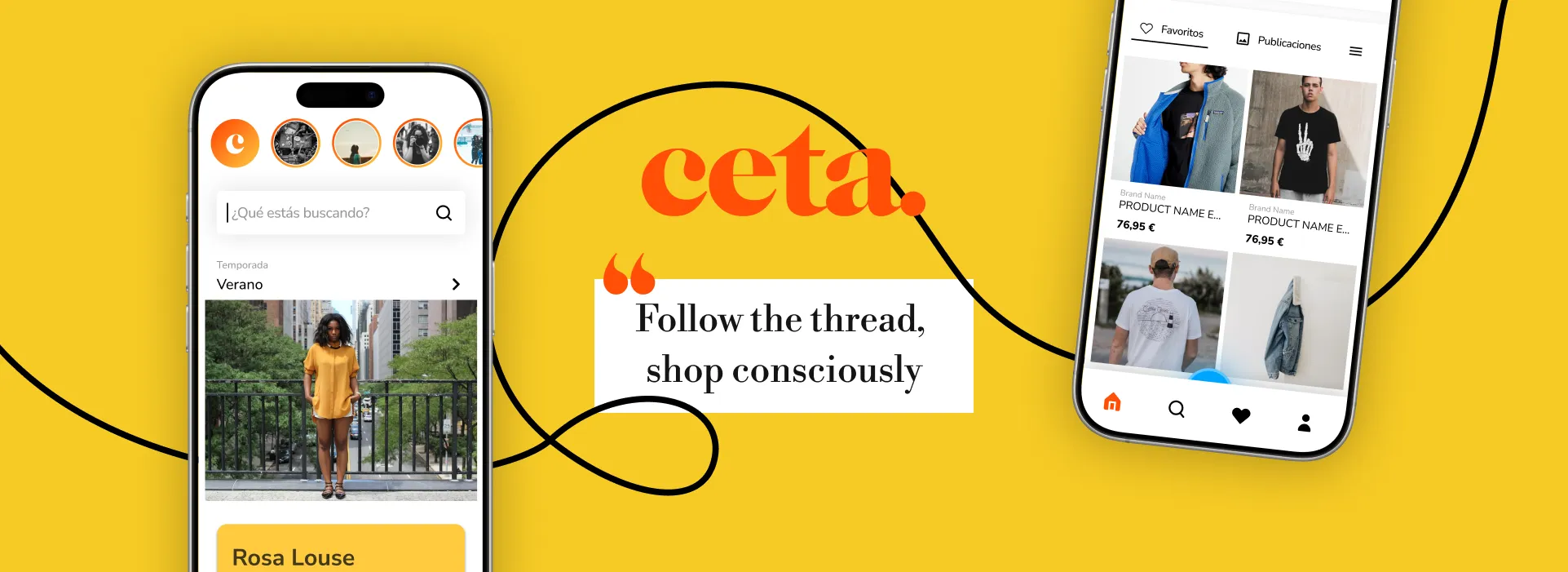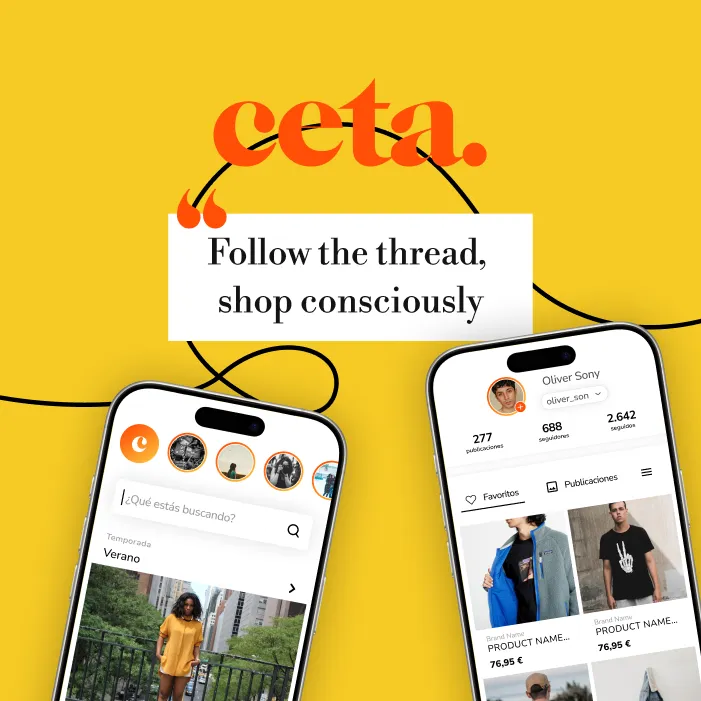



Challenges
Develop a seamless, intuitive platform that helps users verify the authenticity and quality of textiles, ensuring they meet sustainable and ethical standards.

Data Visualization and Traceability
The challenge was to transform complex data about the origin and manufacturing process into clear, accessible information for users.

Affordable Access to Sustainable Clothing
The goal was to make sure users could find sustainable fashion options without price being a barrier.
Problem Statement
Consumers struggle to access transparent information about product sustainability and traceability, while also perceiving eco-friendly options as unaffordable, leading to uninformed and unsustainable purchasing decisions.
User Research
To create a solution that truly met user needs, we conducted six in-depth interviews, two focus groups, and a survey with over 400 participants. This research, combined with the analysis of official and third-party data, helped us gain key insights into user behavior and expectations around sustainable fashion.
The results were visualized through various analytical tools, which gave us clear insights into user behavior and expectations.

Personas
Based on our findings, we developed two main personas to represent our target users:
- Sustainable Shopper
- Goal: To make eco-friendly purchases that align with their budget and values.
- Frustration: Difficulty finding transparent information about product sustainability.
- Informed Consumer
- Goal: To understand the full lifecycle of a product, including its environmental impact.
- Frustration: Lack of trust in sustainability certifications and unclear pricing for eco-friendly options.

User Intentions & Journey
We mapped out user intentions and interactions to prioritize the most critical features. The Rainbow Diagram highlights key user goals, such as finding transparent product data, comparing sustainable options, and ensuring affordability. Based on these intentions, we crafted a user journey that addressed common pain points:
- During discovery, users struggled to filter sustainable products effectively.
- In the evaluation phase, they found it difficult to trust sustainability claims and compare pricing.
- At checkout, concerns about clarity and the affordability of eco-friendly options led to hesitation.
This mapping guided the development of solutions to improve the overall user experience, ensuring CETA met their needs at every stage.

Competitive Analysis
The research included a benchmarking phase, where we analyzed existing tools and platforms that offered certification verification across various industries. Most competitors lacked a comprehensive and user-friendly solution specifically focused on textiles.
From there, we conducted a comprehensive analysis of all data to address these gaps by providing targeted solutions to improve the search system, data visualization, and the promotion of sustainable purchasing over other options.
Goals
Develop a seamless and intuitive platform that helps users find the most sustainable product within their budget.
- Sustainable clothing vs. cheap clothing: Break the price-only focus by introducing sustainability and quality into the search process. Bring together aspects that often seem at odds.
- Zero returns horizon: Using size prediction technology to prevent multishopping, wardrobing, and purchase errors. Technology at the service of both the user and the planet.
- Sharing values and information: We want to tell the story behind the garments and their brands, bridging the gap with producers and appealing to the emotional value of clothing. What lies between the threads is added value.
- Sustainable and affordable: Ethical consumption as a journey, not a destination. Prevent user frustration and dropout by improving search systems and addressing their specific context. The most sustainable option is the one you can afford.

Design Step
The design process for CETA was guided by the insights gathered during user research, ensuring that each design decision was informed by real user needs. We adopted an iterative approach, involving prototyping, user testing, and feedback loops to refine the platform continuously.
Features and Information Architecture
Based on user research insights, we identified essential features for the CETA platform, including enriched product profiles with traceability data, an advanced search engine for comparing sustainable products, user reviews, educational content, and a personalized size profile powered by AI to reduce returns.

User Flow
To further clarify user interactions, we created user flows for various features. This helped us visualize how users will navigate the platform and accomplish their goals, ensuring a smooth and intuitive experience.

Key Features and Final Prototype
CETA delivers a digital solution that seamlessly combines intuitive design with functionalities aimed at empowering users to make informed purchasing decisions. Every detail has been carefully crafted to not only simplify the search for sustainable products but also foster a meaningful connection with the impact behind each garment. Below, we present the platform's key features along with a glimpse of the final prototype.
Log in & Onboarding
Access the platform and take the first step toward more conscious consumption.
During the onboarding process, we emphasize the app's values and philosophy, along with an introduction to its key features.
Discover how CETA can support you in making responsible and sustainable fashion choices.


Advanced Product Search
The search engine was designed to streamline the discovery of sustainable clothing options.
With advanced filtering capabilities, users can compare products based on sustainability metrics, quality certifications, and price, enabling a more informed and responsible decision-making process.
This approach not only enhances user experience but also fosters a deeper connection to the values of sustainability and conscious consumption.
Influencers & Collaborations
This feature allows users to engage with trusted influencers and brands that share the platform’s values, offering recommendations and promoting sustainable fashion choices.
By fostering collaborations, the platform creates a community-driven space where influencers contribute to educating consumers on the importance of sustainable fashion.
The goal is to create a space for authentic partnerships that align with the app’s mission, ensuring users have access to relevant and impactful content that further promotes responsible shopping.


AI Fashion Assistant
he AI Fashion Assistant is a core feature of the app that uses advanced machine learning to provide personalized fashion recommendations based on the user’s style preferences, body measurements, and sustainability priorities.
Through a dynamic chatbot interface, the assistant engages users in a conversational manner to offer tailored outfit suggestions and advice.
The AI is designed to understand the user’s needs and values, helping them make informed decisions while keeping sustainability at the forefront.
This feature aims to guide users towards making choices that reflect both their personal style and commitment to eco-friendly fashion.
Sustainability Visualization & Standards
The Sustainability Visualization and Standards feature offers users a clear, transparent view of each product's sustainability credentials.
By providing enriched product pages, users can easily assess the environmental and social impact of their clothing choices.
The feature includes detailed data about production processes, materials used, certifications, and comparisons with other products in terms of sustainability.
This empowers users to make conscious purchasing decisions, aligned with their environmental and ethical values, while enhancing the overall transparency of the fashion industry.
.webp)
Conclusion and Learnings
The development of CETA has been a comprehensive experience, showcasing the transformative power of digital product design in promoting responsible and sustainable consumption habits.
This project not only tackled complex challenges such as product traceability and access to sustainable fashion but also strengthened my ability to lead iterative and user-centered design processes.
Key highlights of the product include leveraging advanced technologies like artificial intelligence for personalized profiles and emphasizing transparency as a core value.
One of the most significant lessons was understanding the importance of combining practical functionalities with an emotional narrative that connects users with the product's values. This underscores the commitment to human-centered design, ensuring decisions are both effective and meaningful.